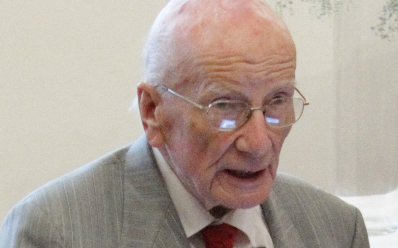Institut Charles Sadron News

Publié le 17/10/2023 par Drenckhan Wiebke
Professor Charles Sadron welcomed Paul Rempp to the Centre d’Étude de la Physique des Macromolécules in October 1950 and offered him to work for his PhD thesis on the synthesis of linear poly(ethylene oxide) (PEO) and on the characterization of their physicochemical properties. Sadron's contagious enthusiasm and his great open-mindedness quickly convinced the young Paul that contributing to a still nascent science at that time and working in this little-explored field would open him promising prospects. However, the study of the properties of PEO in dilute solution implied the availability of polymers with low dispersity and well-controlled molar mass. However, at the time, the synthesis of well-defined PEOs required a tedious fractionation step and was limited to low molar masses. [1] The discovery in 1956 of the “living” nature of the anionic polymerization of certain monomers by Michael Szwarc, in other words the finding that anionic chains can propagate without termination or transfer, opened up new perspectives. Returning from a stint in the United States, Paul Rempp took advantage of this discovery and contributed through his research activity to the theme of low polydispersity polymers obtained by anionic polymerization of vinyl monomers and heterocycles. This is how he became the first to publish the synthesis of styrene-ethylene oxide block copolymers, [2] made of carbon and oxygenated sequences within the same chain. Shortly after, in the same laboratory of the Centre de Recherche sur les Macromolécules (CRM), Antoine Skoulios demonstrated the amphipathic nature of these block copolymers and revealed the existence of distinct phases, organized in either sheets or cylinders within these samples: [3] for the first time, the term mesomorphic phases was introduced. We now know the importance taken by this theme over time in polymer science! Another remarkable outcome of the collaboration between Paul Rempp and the physicochemists of CRM on this theme of well-defined polymers was the publication of the famous article on the universal calibration of gel permeation chromatography, cited more than 1500 times. [4]
Paul Rempp then became interested in the design, again by anionic route, of various macromolecular structures: those without terminal ends, i.e. cyclic polymers, and those with controlled degree of branching, i.e. comb polymers, star structures and graft copolymers. [5] P. Rempp's contribution and that of his team to macromolecular engineering gave a lasting impetus to the broad theme of polymer synthesis at CRM, then at Charles Sadron Institute (ICS), triggering numerous collaborations within the laboratory and also elsewhere in France and abroad. On the same theme of polymers with controlled architectures, P. Rempp is the one who designed the so-called model networks ; when labelled with perdeuterated chains and characterized by neutron scattering, these model networks contributed to a better understanding of the deformation of elastic chains in response to a mechanical stress. [6] Subsequently, P. Rempp and his team turned their attention to the theme of hydrogels and in particular those made of PEO, aiming for applications in the biomedical field in collaboration with Prof. E. Merrill (MIT, Cambridge, USA) and also with French industries.
Paul Rempp understood very early the importance of macromolecular engineering, a theme that he pioneered. Through his original work, but also through the numerous collaborations he established throughout the world, through the various symposia and conferences he organized (IUPAC 1981), through his involvement in the Groupe Français des Polymères (GFP) – general secretary of the GFP from 1974 to 1980 -, P. Rempp greatly contributed to the influence of the CRM, then the ICS. He was a wonderful speaker/lecturer, able to express himself equally well in English, German and of course French; he was also a remarkable professor who taught polymer chemistry at the École de Chimie de Strasbourg and at the Department of Chemical Engineering at MIT. In collaboration with Prof. E.W. Merrill, he also drew from his courses there a reference textbook on the synthesis of polymers. [7]
Paul Rempp spent his entire career with the Centre National de la Recherche Scientifique (CNRS); he passed away on the eve of his 95th birthday.
Pierre Lutz & Yves Gnanou
References :
[1] Bull. Soc. Chem. Fr. 1957, 5, 844
[2] Bull. Soc. Chem. Fr. 1962, 2, 262
[3] J. Chem. Phys., 1962, 59, 473
[4] J. Polym. Sci., Part B: Polym. Lett., 1967, 5(9), 753
[5] Adv. Polym. Sci., 1988, 86, 147
[6] J. Polym. Sci., Part B: Polym. Phys., 1976, 14(12), 2119
[7] “Polymer Synthesis”, Hüthig & Wepf, Heidelberg and New York, 1991